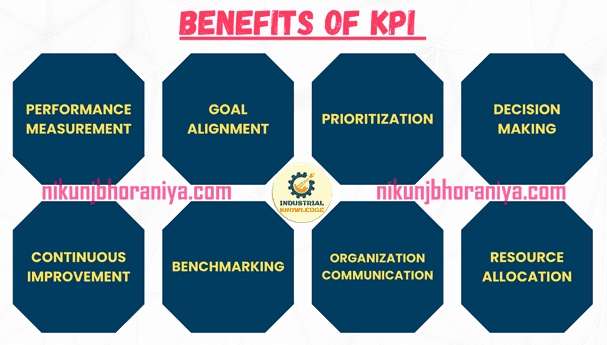Key Performance Indicator (KPI) Guide and Examples
→ In the current scenario the market has very much competition in all sectors so it is very important to monitor the performance of our business.
→ The terminology used for monitoring different parameters of our business is known as the Key Performance Indicator.
→ The acronym of the Key Performance Indicator is KPI.
Table of Contents:
What is a KPI?
→ KPI stands for Key Performance Indicator.
→ It is a measurable value or metric that organizations use to evaluate their progress toward achieving specific objectives or goals.
→ KPIs are commonly used in business and management to assess the performance of different areas or aspects of an organization.
→ A Key Performance Indicator (KPI) is a measurable value that helps organizations track their progress toward their goals and objectives.
→ KPIs are typically used to measure performance across a variety of areas, such as sales, marketing, customer service, and operations.
→ KPIs vary depending on the industry, department, and objectives of the organization.
→ They are typically tied to specific targets or benchmarks and are used to monitor performance, identify areas for improvement, and make data-driven decisions.
→ The selection of KPIs should align with the organization's overall strategy and reflect the critical factors that contribute to its success.
→ It's important to choose KPIs that are relevant, measurable, and actionable, allowing organizations to track progress and make informed decisions based on the results.
→ KPIs assist organizations in identifying their strengths and weaknesses, making data-driven decisions, and optimizing their performance.
→ Organizations may discover areas of strength and weakness, make data-driven choices, and take actions to optimize performance by monitoring KPIs.
Examples of KPIs (Key Performance Indicators)
→ The different department has different KPIs.
→ For better understanding refer to the below department-wise examples of KPIs.
- Quality Department
- Manufacturing Department
- Marketing Department
- Sales Department
- Customer Service
- Dispatch Department
- Human Resources
Quality Department
→ The most common Quality Department KPIs are listed below.
- Defect rate
- Rework rate
- Customer complaint rate
- Time to resolve customer complaints
- First-time yield
- Process cycle time
Manufacturing Department
→ The Manufacturing Department is the heart of the industry.
→ Manufacturing has many KPIs that depend on the industry.
→ Also some specific KPIs are changed from company to company but out of all KPIs we have listed down the most common KPIs.
- Production output
- Machine uptime
- Cycle time
- Work-in-process (WIP)
- Defect rate
- Rework rate
- Cost per unit
- Productivity
Marketing Department
→ Refer to the below-mentioned KPIs of the Marketing Department
- Cost per acquisition (CPA)
- Customer lifetime value (CLTV)
- Return on investment (ROI)
- Conversion rate
- Lead generation rate
Sales Department
→ The sales department has many KPIs but out of them we have listed the most useful ones.
- Sales target
- Sales per employee
- Average deal size
- Close rate
- Customer satisfaction score (CSAT)
Customer Service
→ Refer to the below-mentioned customer service department's KPIs.
- Average response time
- First-time resolution rate
- Customer satisfaction score (CSAT)
- Net promoter score (NPS)
Dispatch Department
→ Dispatch department's KPIs are listed below.
- Dispatch time
- On-time delivery
- Customer satisfaction
- Driver satisfaction
- Cost per km
- Cost per delivery
Human resources
→ The Human Resources department has many KPIs to track.
→ Out of all KPIs we have listed down the most common KPIs of Human Resource.
- Employee satisfaction rate
- Employee turnover rate
- Time to hire
- Training ROI
- Absenteeism rate
Key Characteristics of KPIs:
→ KPIs should be specific, measurable, achievable, relevant, and time-bound objectives.
→ In simple language we can say that KPIs should be "SMART".
→ The acronym "SMART" stands for specific, measurable, achievable, relevant, and time-bound.
→ Also, visit the SMART Goal Setting Presentation.
→ Refer to the below key characteristics of KPIs:
- Specific
- Measurable
- Achievable
- Relevant
- Time-Bound
1. Specific:
→ KPIs should be specific and relevant to the organization's goals and objectives.
→ KPIs should not be generic. If it is generic then it is very difficult to track, identify, and improve it.
2. Measurable:
→ KPIs should be quantifiable and easy to measure.
→ Quantifiable means they should be indicated in numbers or other measurable terms, such as percentages, ratios, or time frames.
3. Achievable:
→ KPIs should be achievable.
→ Achievable means it should be realistic and achievable in line with available resources and capabilities.
4. Relevant:
→ KPIs should be relevant.
→ Relevant means it should be aligned with the organization's overall goals and objectives.
5. Time-Bound:
→ KPIs should be timebound.
→ Timebound means they should have a specific timeframe for measurement.
→ It helps us to ensure that the organization is on track with its goals.
What are the benefits of KPIs?
→ Key Performance Indicators (KPIs) provide several advantages to business/industry.
→ Refer to the below-mentioned benefits of Key Performance Indicators Tracking.
- Performance Measurement
- Goal Alignment
- Prioritization
- Decision Making
- Continuous Improvement
- Benchmarking
- Organization Communication
- Resource Allocation
1. Performance Measurement:
→ KPIs enable businesses to assess and track their performance in relation to certain objectives and goals.
→ They provide a clear picture of how well the organization is performing in meeting its strategic goals by quantifying progress.
→ So this way we get the benefits of performance measurement.
2. Goal Alignment:
→ KPIs help individuals and teams to align with the organizational goal.
→ When everyone is aware of the main goals and targets, then all people can contribute to the success of the organization.
3. Prioritization:
→ KPIs assist in focusing attention on the most crucial areas that need improvement or priority.
→ They allow management to properly prioritize efforts and allocate resources.
4. Decision Making:
→ KPIs provide data and that data helps organization to make decisions.
→ They provide insights into the current technique and how we need to change it.
5. Continuous Improvement:
→ KPIs promote a culture of continual improvement within the organization.
→ With the help of regularly monitoring and analyzing KPI data, we can identify areas for improvement.
→ After identifying the improvement opportunity we can implement changes to enhance our performance.
→ Also, visit the KAIZEN Continuous Improvement Presentation.
6. Benchmarking:
→ KPIs allow organizations to compare their performance with industry standards or competitors.
→ This benchmarking process helps an organization to identify the areas where the organization is doing good and where it is doing bad.
→ So this way we can identify the area of improvement with the help of benchmarking.
7. Organization Communication:
→ KPIs provide a common language for communicating performance to all employees in the organization.
→ KPIs promote transparency.
→ With the help of setting KPIs everyone is aware of the organization's performance and the progress made toward achieving goals.
8. Resource Allocation:
→ KPIs help in optimizing resource allocation.
→ By identifying high-impact areas, organizations can optimize resource allocation.
→ Organizations can track the usage of resources and optimize the use of different resources like time, money, manpower, etc.
→ That will help the organization to improve profitability.
→ So now we can say that KPIs are very important for an organization's overall success and growth.
👉 Also Visit Our Popular Articles:
➨ Lean Manufacturing and Lean Six Sigma






Post a Comment